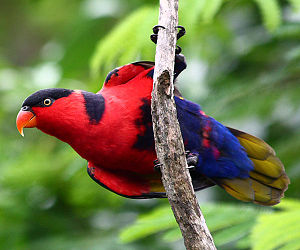Woman Lorikeet
| Woman Lorikeet | ||||||||||||
|---|---|---|---|---|---|---|---|---|---|---|---|---|

Female lory ( Lorius lory ) |
||||||||||||
| Systematics | ||||||||||||
|
||||||||||||
| Scientific name | ||||||||||||
| Lorius lory | ||||||||||||
| ( Linnaeus , 1758) |
The Frauenlori ( Lorius Lory ) is a species from the genus of Breitschwanzloris ( Lorius ). In their homeland, they are also kept as pets by the Papuans (a native ethnic group). The basic color of the plumage is predominantly red, which runs from the head to the nape of the neck in purple. The middle of the abdomen, the middle of the chest, the neck band, the lower wings and the thighs are deeply dark blue, except for the wings, which are colored green. The iris is reddish brown and the eyes with an almost white, bare eye ring. The beak is orange and the feet are blackish gray. They reach a height of approx. 31 cm and a weight of 200 to 260 g.
Females are significantly smaller, but without sex differences due to plumage.
Young animals are duller in color, with a black-brown beak and yellow-black spots on the outer feathers.
Way of life
In its homeland, the female lory is a very common, shy parrot that you can almost never approach. Its habitat is in dense rainforests up to an altitude of 1600 m. Female lorises live in the upper tree regions in small groups of up to 15 animals (also in pairs during the breeding season). They can be found wherever there are enough flowers and fruits. They are diurnal animals that breed mainly in tree hollows.

nutrition
As with all Loris (parrots) , food is consumed through a long, narrow tongue, the tip of which is densely covered with papillae. The main food in nature of this species of lory are pollen, nectar, insects, nuts, seeds, fruits and berries.
distribution
Mainly New Guinea from the southern Cenderawasih Bay to the Onin and Huon Peninsula .
Reproduction
The breeding season is in spring and breeding begins in April. The normal clutch of the female Loris consists of two to three eggs and the incubation period is 25 to 26 days. Only the females breed. The nestling period is 50 to 55 days, after which the young birds leave the nest. Two weeks after leaving, they are self-employed. The birds reach full sexual maturity after two years.
Keeping and breeding
The keeping of this Lori species is very popular because it is very beautiful and less demanding animals. The parrots are easy to breed and can be found in many households. Nevertheless, like other parrots, they should only be kept in pairs, also because the cocks often become very aggressive towards other parrots. A species-appropriate housing is only possible in an indoor or outdoor aviary, as they require a lot of space. Since they are not large rodents, the aviary can consist of normal wire mesh. It is necessary to install a sleeping box in this, as they spend the night in tree hollows in the wild. Like other lory species, female lorises bathe as extensively as they like, so regular sprinkling with water should be a matter of course.
photos
Subspecies
In addition to the nominate form , various subspecies are known. These differ mainly in the extent and color of the blue or black areas in the neck and on the chest and are mostly to be found in separate areas. In addition to the nominate form, the Lorius lory lory , simply referred to as the female lory , the following subspecies have been described:
- Biak Frauenlori ( Lorius lory cyanauchen ( S. Müller , 1841))
- Salvatori Frauenlori ( Lorius lory erythrothorax ( Salvatori , 1877))
- Jobi Frauenlori ( Lorius lory jobiensis ( AB Meyer , 1874))
- Meyer´s Frauenlori ( Lorius lory salvatorii A. B. Meyer , 1891)
- Somu Frauenlori ( Lorius lory somu ( Diamond , 1967))
- Beaufort's Frauenlori ( Lorius lory viridicrissalis Beaufort , 1909)
In some sources you can also find:
- Large female lory ( Lorius lory major Rothschild & Hartert )
- Salvadori Frauenlori ( Lorius lory rubiensis A. B. Meyer , 1891)
Both are now regarded as synonymous with the nominate form.
Web links
- Bird club Bad Lauchstaedt
- tierportraet.ch
- Lorius lory inthe IUCN 2013 Red List of Threatened Species . Listed by: BirdLife International, 2012. Retrieved October 7, 2013.
swell
- ↑ a b c Joseph M. Forshaw , illustrated by William T. Cooper: Australian Parrots. 1st German-language edition. Volume 1: Cockatoos and Lories. Arndt-Verlag, Bretten 2003, ISBN 978-3-9808245-1-4 .
- ↑ a b c d e Vogelverein-Bad Lauchstaedt
- ↑ tierportraet.ch
- ^ Theo Pagel: Loris: Free life, keeping and breeding of the brush-tongued parrots. Ulmer, Stuttgart / Berlin / Hamburg 1998, ISBN 3-8001-7352-2 , pp. 122-124.
- ↑ www.itis.gov - ITIS Standard report - Status 03.201



